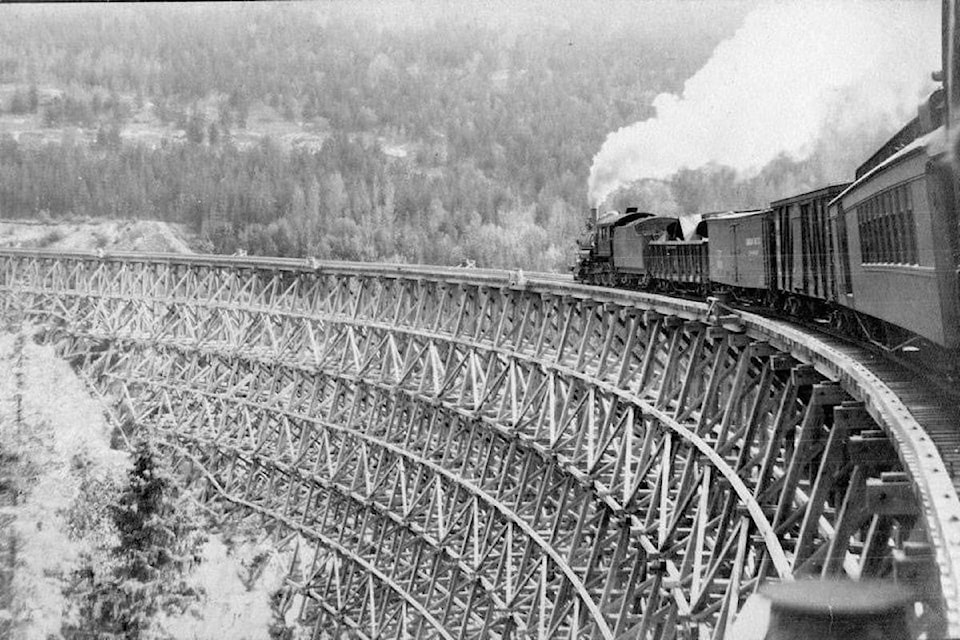In the last half of the 19th century, two major gold rushes and the discovery of high quality silver in the southern interior resulted in a huge influx of Americans and the forging of deep commercial ties with Washington state. British Columbians were convinced the United States presented a threat to the province’s authority in the region. The demand for the “Coast-to-Kootenay” rail link was born.
The Canadian Pacific Railway’s initial indifference did nothing to endear it to B.C. residents. The CPR’s stance changed in the 1890s when Daniel Corbin built his railway from Spokane to Nelson and James Hill’s Great Northern Railway entered B.C. From 1895 onward the GNR and the CPR battled for the best routes in southern B.C. and maneuvered to launch a Coast-to-Kootenay link.
The independent Grand Forks & Kettle River Railway, formed in 1900, underwent many transitions in a desperate attempt to fend off Hill and his predatory GNR. Without help from its main creditor, the Toronto-based Trusts & Guarantee Company, GF&KR would not have survived.
The trust company’s founder, James Stratten, had approached James John Warren, a lawyer, to join his company. The very capable Warren was promoted to manager of the firm in 1905. One of his concerns was his company’s loans to the struggling railway now known as Kettle Valley Lines.
Warren was already familiar with British Columbia. He had developed Rossland’s White Bear mine in the 1890s. He was aware of the province’s promise, and confident that B.C. possessed untapped mineral wealth. All that was needed was a railway to the coast to link with waiting markets abroad.
Warren visited Grand Forks in 1906 to view the operations of the railway. He saw firsthand how difficult the position of KVL had become. He toured the unused, weed-strewn Republic line. He concluded the only way forward was an alliance with the CPR. Warren visited CPR’s head office in 1907. The president of the railway was away, and Warren was rebuffed by his subordinates. He remained determined to do what he must to meet with Thomas Shaughnessy.
Shaughnessy, like Warren, was a true believer in B.C., and like Warren, he had business history in the province. In 1903, he had established the Summerland Development Corporation to purchase land, build a townsite and promote fruit farming to prospective settlers. The corporation established water and electrical services, a school and more. The town prospered.
“Because he [Warren] and Shaughnessy shared a common interest in southern British Columbia and the railway so vital to its future,” wrote Barrie Sanford in McCulloch’s Wonder, “it seemed natural to Warren the two of them should work together to weld the bands of steel between the coast and the Kootenays.”
Warren learned that Shaughnessy would be onboard a steamer to Liverpool in April of 1908, and gamely booked the trans-Atlantic trip. Warren introduced himself to the CPR president aboard the Empress of Britain. They shared concern that if Hill alone should build the Coast-to-Kootenay link, that he would control southern B.C. Shaughnessy emphasized his commitment to the route.
Shaughnessy asked Warren to ready the KVR, as KVL was already popularly known, to build west while he secured financing. Through the rest of 1908, the CPR and the KVR directed surveys from Midway to Meritt where the KVR would link into the existing CPR system and north to the mainline at Spence’s Bridge.
That Shaughnessy readily agreed to an alliance with a struggling railway like KVR is astonishing. An uncommon alignment of views and abundant trust and respect must have been present between the two executives for Shaughnessy to make that leap of faith. Perhaps he recognized that Warren, who assumed the KVR presidency in 1910, possessed the vision to advance and represent the KVR.
At the beginning of 1909, Shaughnessy requested Warren to include a line from the Otter Summit (south of Meritt) connecting directly – through the treacherous Coquihalla Pass – with the main line at HHope. With that, the basic outline of the KVR was finalized.
The GF&KR had transformed many times, and had defied James Hill and the mighty GNR for the best part of a decade. It came to be one of the rare independent charters to both build an operating railway and be acquired by a major railway. The Grand Forks & Kettle River Railway had endured to become the iconic Kettle Valley Railway.
Construction on the line began in 1910. The massive engineering, construction and operating challenges facing the KVR, along with James Hill’s response, were yet to be revealed.
____
Bruce Uzelman, based in ÁđÁ§ÉńÉç, holds interests in British Columbia history as wells as current political and economic issues.
Bruce had a career in small business, primarily restaurant and retail. He holds a Bachelor of Arts, Advanced from the University of Saskatchewan, with Majors in Political Science and Economics.
Contact: urban.general@outlook.com



